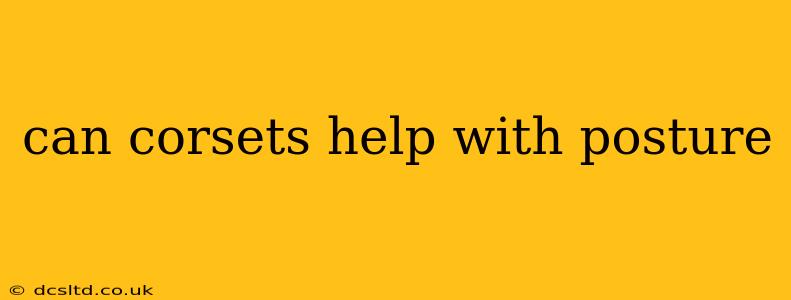Many people wonder if corsets can truly improve posture. The answer isn't a simple yes or no. While corsets can temporarily improve posture by providing external support, their long-term effects on posture correction and overall spinal health are complex and depend on several factors. This guide will delve into the nuances of using corsets for posture improvement, addressing common questions and concerns.
Do Corsets Help with Posture in the Short Term?
Yes, corsets can offer immediate postural support. By cinching the waist and providing structured support around the torso, they can hold the shoulders back and the spine straighter. This can be particularly beneficial for individuals experiencing temporary slouching or those needing immediate postural assistance, such as during long periods of sitting or standing. Think of it like wearing a supportive brace – it helps maintain a correct posture while you're wearing it.
Can Corsets Correct Posture Long-Term?
This is where things get more complicated. While corsets can temporarily improve posture, they don't inherently correct poor posture long-term. The key difference lies in muscle strengthening and retraining. Long-term posture correction requires strengthening the core muscles, back muscles, and shoulder muscles to maintain proper alignment independently of external support. Relying solely on a corset can lead to muscle weakness and dependence on the garment.
What are the Risks of Wearing a Corset for Posture?
Several risks are associated with prolonged or improper corset use:
- Muscle Atrophy: Constant reliance on a corset can weaken core and back muscles, potentially worsening posture in the long run once the corset is removed.
- Rib Cage Compression: Tight lacing can restrict breathing and potentially affect lung capacity.
- Digestive Issues: Excessive compression can interfere with digestion.
- Back Pain: Improperly fitted or overly tight corsets can cause or exacerbate back pain.
- Nerve Damage: In rare cases, extremely tight lacing can put pressure on nerves.
Are There Alternatives to Corsets for Posture Improvement?
Yes, there are many safer and more effective ways to improve posture in the long term:
- Physical Therapy: A physical therapist can assess your posture, identify underlying issues, and create a personalized exercise program to strengthen your core and back muscles.
- Yoga and Pilates: These practices emphasize core strength, flexibility, and body awareness, which are crucial for maintaining good posture.
- Ergonomic Adjustments: Modifying your workspace to ensure proper ergonomics (chair height, desk position, monitor placement) can significantly impact posture.
- Mindfulness and Posture Awareness: Consciously paying attention to your posture throughout the day and making adjustments can help you maintain correct alignment.
How Can I Choose the Right Corset for Posture Support (If I Choose to Use One)?
If you decide to use a corset for temporary posture support, prioritize the following:
- Proper Fit: A corset should be comfortable and not overly tight. It should support, not constrict. A professional fitting is recommended.
- Material Quality: Choose a corset made from breathable, high-quality materials.
- Short-Term Use: Remember, a corset is a tool for temporary support, not a long-term solution for posture correction.
What Exercises Can Help Improve My Posture?
Numerous exercises target core and back muscles crucial for good posture. Examples include:
- Plank: Engages core muscles.
- Bird-dog: Strengthens back and core.
- Rows: Strengthen back muscles.
- Shoulder blade squeezes: Improves upper back posture.
It's vital to consult a physical therapist or other qualified professional to design a personalized exercise program tailored to your specific needs and posture issues.
Conclusion
While corsets can offer temporary postural support, they are not a long-term solution for posture correction. Prioritize building core strength, improving flexibility, and practicing good posture habits for lasting results. Remember, proper posture is a holistic endeavor that requires a combination of exercise, lifestyle adjustments, and potentially professional guidance.
